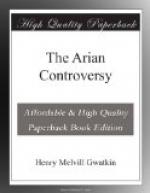in the Father;
in the Son;
in the Holy Spirit;
and in one Baptism of Repentance.
The Roman form, as approximately given by Novatian in the middle of the third century, was,
I believe in God the Father,
the
Lord Almighty;
in
Christ Jesus his Son,
the
Lord our God;
and in the Holy
Spirit.
Though these local usages were not disturbed, it was none the less a momentous step to draw up a document for all the churches. Its use as a test for bishops was a further innovation. Purity of doctrine was for a long time guarded by Christian public opinion. If a bishop taught novelties, the neighbouring churches (not the clergy only) met in conference on them, and refused his communion if they proved unsound. Of late years these conferences had been growing into formal councils of bishops, and the legal recognition of the churches by Gallienus [Sidenote: c. 261.] had enabled them to take the further step of deposing false teachers. Aurelian had sanctioned this in the case of Paul of Samosata by requiring communion with the bishops of Rome and Italy as the legal test of Christian orthodoxy. [Sidenote: 272.] But there were practical difficulties in this plan of government by councils. A strong party might dispute the sentence, or even get up rival councils to reverse it. The African Donatists had given Constantine trouble enough of this sort some years before; and now that the Arians were following their example, it was evident that every local quarrel would have an excellent chance of becoming a general controversy. In the interest, therefore, of peace and unity, it seemed better to adopt a written test. If a bishop was willing to sign it when asked, his subscription should be taken as a full reply to every charge of heresy which might be made against him. On this plan, whatever was left out of the creed would be deliberately left an open question in the churches. Whatever a bishop might choose to teach (Arianism, for example), he would have full protection, unless some clause of the new creed expressly shut it out. This is a point which must be kept in view when we come to estimate the conduct of Athanasius. Thus however Constantine hoped to make the bishops keep the peace over such trumpery questions as this of Arianism seemed to him. Had it been a trumpery question, his policy might have had some chance of lasting success. For the moment, at any rate, all parties accepted it, so that the council had only to settle the wording of the new creed.




